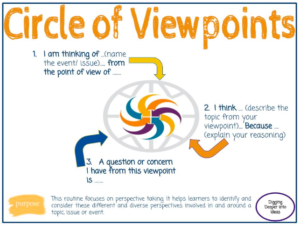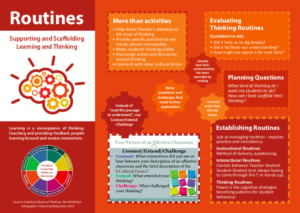Routines to Support and Scaffold Learning & Thinking
Visit any great classroom and you will see a series of routines in action. These routines may be procedural, instructional and/or focused on getting the best thinking from the students.
Routines help to minimise distractions, add to the positive classroom flow, encourage responsibility, and can boost moral in a learning environment. They also provide a clear framework, or boundaries in which students can work within.
Establishing routines, whether procedural, instructional or thinking requires explicit teaching of the routine, time to practice it and feedback to constantly improve and refine. Gaining student voice is an important phase in the successful implementation of new routines and also requires the teacher to step back and allow students to run the routines.
According to Ron Ritchhart, thinking routines are more than just activities. He maintains they are designed to:
- Help direct the students and teachers’ attention to the issue of thinking
- Provide specific practices to see the results almost immediately
- Make students thinking visible
- Encourage action and discussion around thinking
One of the aims of using thinking routines is to assist in the cognitive strategies becoming patterns of behaviour. If we want our students to be great thinkers, we must support and scaffold this learning and thinking. Ron Ritchhart along with others at Project Zero have developed many thinking routines. Below is an introduction to a few. They can all be found on The Project Zero website www.pz.harvard.edu/resources/visible-thinking-tools
A great place to start is to identify what kind of thinking you would like your students to engage in and provide thinking routines to support this. These may vary according to the subject area, students experience and the topic you are teaching. For example, if you wish to introduce and explore ideas, possibly at the beginning of a topic of study, you may use the following two routines.
 See-Think-Wonder is a routine for exploring works of art or ambiguous or complex visual stimuli. The purpose of this routine is to encourage students to make careful observations and thoughtful interruptions. It helps stimulate curiosity and sets the stage for inquiry. By separating the two questions, What do you see? and What do you think about what you see?, the routine helps students distinguish between observations and interpretations. By encouraging students to wonder and ask questions, the routine stimulates curiosity and helps students reach for new connections.
See-Think-Wonder is a routine for exploring works of art or ambiguous or complex visual stimuli. The purpose of this routine is to encourage students to make careful observations and thoughtful interruptions. It helps stimulate curiosity and sets the stage for inquiry. By separating the two questions, What do you see? and What do you think about what you see?, the routine helps students distinguish between observations and interpretations. By encouraging students to wonder and ask questions, the routine stimulates curiosity and helps students reach for new connections.
The thinking routine of the Compass Points is ideal to use when wanting to get the groups ideas about a plan, proposal or when making a decision. The four points of the compass, North, South, East and West make up this routine. While they can be used in any order, the points are generally used as follows:
- E = Excited. What excites you about this idea or plan? What’s the upside or positives?
- W = Worrisome. What do you find worrisome about this idea or plan? What’s the downside or negatives?
- N = Need to Know. What else do you need to know about this idea or plan? What additional information will help you to evaluate it?
- S = Stance or Suggestions. What is your current stance or opinion on the idea or plan? What other suggestions might you make?
Thinking routines for synthesising and organising ideas include the CSI: Colour-Symbol-Image or the I Used to Think…Now I Think protocol.
CSI: Colour-Symbol-Image routine asks students to identify and distil the essence of ideas taken from their reading, viewing or listening. Students are invited to choose a colour, symbol and image that they feel best represents the essence of an idea. They are then asked to share this with a partner or a small group, to deepen their knowledge, understanding and perspective.
I Used to Think…Now I Think is a great protocol to evaluate how students thinking has changed and shifted over time. Simply invite them to reflect on how their thinking has changed, due to the learning, discussions and perspectives they have gained over a period of time.
If you are wanting to dig deeper into ideas, the thinking routines of What Makes You Say That, and Circle of Viewpoints are great tools.
What Makes You Say That is a routine which deepens students answers. Instead of just giving one or two word answers, this routine assists with interpretation and justification of the answers and builds on students explanations. It encourages evidence-based reasoning and the acceptance of varied viewpoints.
 The Circle of Viewpoints assists with perspective taking. Start with brainstorming a list of different perspectives. In groups have students explore the issue or problem from a particular stance. Share the different thinking from each group/perspective.
The Circle of Viewpoints assists with perspective taking. Start with brainstorming a list of different perspectives. In groups have students explore the issue or problem from a particular stance. Share the different thinking from each group/perspective.
Evaluating a Thinking Routine
It is important to take the time after using a thinking routine to evaluate its use and effectiveness. Questions which may support this process include:
- Did this thinking routine help us to dig deeper?
- Did it facilitate a better understanding?
- How might we adjust this routine for next time?
Providing Thinking Routines helps to layout the sequence and therefore the foundations of skilful thinking. It can demystify the process of thinking and learning. It is important to note these thinking routines are to be used with flexibility and are not a rigid approach.
Add a couple of thinking routines into your lesson plans and you will begin to see your students attitudes towards thinking and learning open up, become more curious and foster a deeper commitment to understanding rather than simply just knowing an answer.
To download a complimentary copy of this infographic please click here
** This article is the eighth in a series of 8, focusing on the 8 Cultural Forces and Cultures of Thinking.
Want to know more?
Please go to www.spectrumeducation.com/cultures-of-thinking-webinar-series for a live webinar or contact us for information about the recorded videos from this series.
To purchase and download all 8 posters please go to www.spectrumeducation.com/cultures-of-thinking-infographics/
Tags: 8 Cultural Forces, Cultures of Thinking, Karen Boyes, Karen Tui Boyes, routines, thinking
Published on Friday, October 4th, 2019, under Cultures of Thinking

